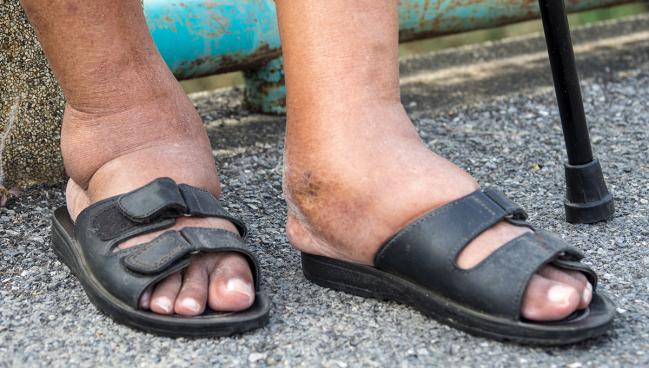AHA Scientific Statement Takes Aim at PAD Pain
The writing committee says collaborative efforts and patient-level perspective can improve management of pain in this population.

Multimodal team-based pain management is needed in the care of patients with PAD to address the lived experience and improve outcomes, a scientific statement from the American Heart Association contends.
“A lot of the treatments for PAD are focused on improving the perfusion in the leg and treating cardiovascular risk factors and metabolic risk factors, but we know that the problem of pain and the processing of pain doesn't happen in your leg,” said writing committee chair Kim G. Smolderen, PhD (Yale University School of Medicine, New Haven, CT). “It's really a complex interplay of multiple factors that determine how intense you feel pain, how frequent you feel it, and what the trajectory will be.”
Importantly, Smolderen and colleagues note, no standards exist for pain management in PAD patients. For some, leg pain can lead to fear that exercise will worsen it despite the importance of exercise for peripheral vascular disease. For others, especially in advanced stages of disease, it may lead to severe disability and even addiction as a consequence of opioid use.
A theme of the scientific statement, published February 10, 2025, in Circulation: Cardiovascular Quality and Outcomes, is that pain needs to be understood from a variety of perspectives, including physical, emotional, and behavioral. Furthermore, the writing committee says it’s time for a change from treating PAD- and even chronic limb-threatening ischemia (CLTI)-related pain as episodic to acknowledging it as a chronic pain syndrome associated with the disease.
“We noticed in some of the studies we reviewed that many people with PAD experience pain that lasts longer than 6 months and that is really consistent with the definition of chronic pain,” Smolderen added. “Once pain becomes chronic, it also becomes more complex to manage.”
While much of the pain that patients experience is ischemic in nature, the writing committee notes that it “may coexist with chronic postsurgical or posttraumatic pain, and with chronic neuropathic pain.”
To TCTMD, Smolderen said the statement was formed as a way to think through the multifaceted experience of pain in a biopsychosocial way and lay a foundation to guide needed research into holistic PAD pain management strategies, including psychological or psychologically informed interventions that prioritize patient-centered care.
No Tools for Concise Assessment
According to the statement, the treatment of pain in PAD should begin with the recommendation of supervised exercise therapy followed by cilostazol. But current PAD guidelines do not give much guidance on other medications, either opioid or nonopioid, for managing pain in this population. While some nonrevascularization options such as spinal cord stimulation, lumbar sympathectomy, intermittent pneumatic compression, and hyperbaric oxygen therapy may be effective for some PAD patients with pain, Smolderen and colleagues say the guidelines as well as consensus documents “weakly advocate their use to mitigate amputation risk and alleviate pain in carefully selected patients.”
The lack of disease-specific questionnaires or scales for assessing the multifaceted pain experience in PAD and CLTI is an obvious gap that needs to be addressed, the scientific statement notes. Despite the existence of some PAD-specific instruments to assess disease burden and the patient’s experience, none of them directly capture intensity, frequency, or the true impact of pain on the patient’s activities of daily living.
”We don't have that in one compact assessment tool, so [it] would certainly be an advantage in this population,” Smolderen noted.
Documenting pain and its arc over time is important, too, the committee asserts. A section of the scientific statement discusses how clinicians can and should add extension codes related to pain severity and temporal features to improve the accuracy of the overall picture of the pain experience.
Smolderen and colleagues also say that borrowing from insights gathered from other pain disorders may help improve understanding of pain and its trajectory in PAD, including early detection of patients at high risk for disability.
Perhaps the biggest goal that the committee believes needs to be achieved to improve the management of pain in this population is team-based PAD care.
“In the paper we reflect on what PAD care could look like in a value-based care setting. You would have to have the matching incentives to bring a team like that together so that better outcomes can be achieved,” Smolderen said. “This is already happening in settings like knee and hip replacement surgery. So, there are models out there, and I do believe we can get there.”
One recent example of multidisciplinary care working well in peripheral disease was seen in the OPTIMIZE PAD-1 study, in which the involvement of clinical pharmacists, aided by algorithms, improved medical therapy management and impacted outcomes.
Lastly, Smolderen said, many lingering questions remain in PAD pain that go beyond the limits of current research.
“We still don't know who is most at risk of experiencing high-intensity pain. So, the importance of additional research cannot be overstated. The mechanisms and potential treatment targets may be different for patients with PAD than other chronic pain populations,” she explained. “That work is necessary to bring this to a level where we can come at it with a more precision-based approach.”
L.A. McKeown is a Senior Medical Journalist for TCTMD, the Section Editor of CV Team Forum, and Senior Medical…
Read Full BioSources
Smolderen KG, Ujueta F, Behan DB, et al. Understanding the pain experience and treatment considerations along the spectrum of peripheral artery disease: a scientific statement from the American Heart Association. Circ Cardiovasc Qual Outcomes. 2025;Epub ahead of print.
Disclosures
- Smolderen reports being a consultant/advisory board member for Terumo, Happify, and Cook.






Comments